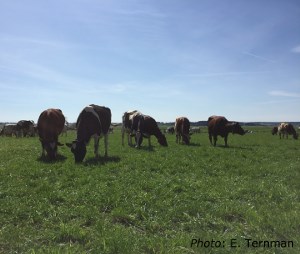Project responsible: Horacio Gonda, Department of Animal Nutrition and Management, SLU Uppsala.
Project group: Emma Ternman, Department for Animal Science, Aarhus University, Denmark; Rolando Vibart, AgResearch, New Zealand; Rebecca Danielsson, Department of Animal Nutrition and Management, SLU Uppsala; Eva Spörndly, Department of Animal Nutrition and Management, SLU Uppsala.
A well-managed pasture can be beneficial both economically and in animal welfare perspective. However, getting a well-functioning pasture can be challenging, as the cows are not always motivated to seek pasture. It is therefore important to take advantage of cow’s daily grazing patterns.
Previous studies have reported that grazing at dusk provides the longest and most intense grazing of all grazing events seen throughout the day. An increase in milk production and increase in fat and protein yield has been observed in cows grazing in the afternoon compared to the morning, which might be due to the difference in the nutritional content of the pasture. The dry matter and soluble carbohydrate content increase during the day, while the content of structural carbohydrates and crude protein decreases. This indicates that the plant nutritional value is higher in the afternoon than in the morning due to a better balanced fermentation ratio of carbon / nitrogen, which might improve intake, milk yield and efficiency of utilization of the nitrogen in the feed.
By combining two natural processes,
- the daily variation in the chemical composition of the grass and
- the natural motivation of the cows to graze,
this project aims to stimulate increased grazing intake in dairy cows. We will compare, morning and afternoon grazing, and evaluate differences in
- milk production and composition,
- feed intake and nitrogen utilization,
- cow-activity,
- milking frequency and
- grazing behaviour.
A controlled study will be conducted year 1 at Lövsta Research Center, SLU, Uppsala. Year 2 study will be based on year 1 results, and three organic farms will be recruited to evaluate our results under commercial conditions.
The project starts in 2021 and lasts for 3 years
